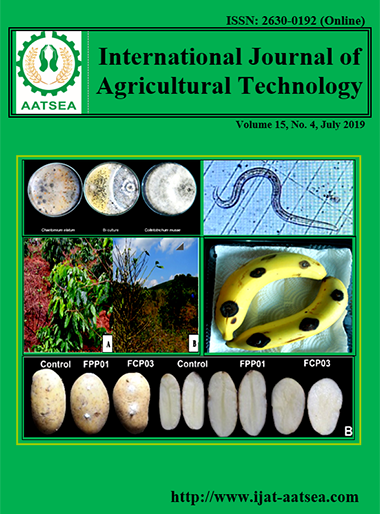Investigation of microfungi from urea plots at pine forest in Bidoup – Nui Ba National Park, Lam Dong Province, Vietnam
Main Article Content
Abstract
The 24 strains of anamorphic fungi were isolated from plots which applied urea 11 months ago, in the forest of Pinus dalatensis at Bidoup - Nui Ba National Park, Lam Dong Province, Vietnam. Based on morphology, isolated strains were identified as Aspergillus, Penicillium, Trichoderma and Acremonium. All of them had ability of cellulose decomposition when cultured on Czapek-Dox agar added carboxymethyl cellulose (CMC). Some strains showed a high cellulose decomposition. The effect of nitrate-nitrogen concentration on their mycelia growth were also demonstrated. Most of the highest dry biomass of mycelia were obtained when cultivated with 13g/L nitrate-nitrogen concentration. Some strains tolerated to nitrate-nitrogen concentration of 13g/L in medium.
Article Details

This work is licensed under a Creative Commons Attribution-NonCommercial-NoDerivatives 4.0 International License.
References
Babla, S. B. (2012). Growth Responses of Ammonia Fungi to Organic and Inorganic Nitrogen. (PhD Thesis). Graduate School of Horticulture, Chiba University, Chiba, Japan.
Clements, F. E. and Shear, C. L. (1964). The genera of Fungi. Hafner Publishing Company, New York, USA, pp. 23-232.
Fukiharu, T. and Hongo, T. (1995). Ammonia fungi of Iriomote Island in the southern Ryukyus, Japan and a new ammonia fungus, Hebeloma luchuense. Mycoscience, 36:425-430.
Fukiharu, T. and Horigome, R. (1996). Ammonia fungi in the Abukuma Mountains and its biogeographical distribution around Japan (in Japanese with English summary). Memoirs of the National Science Museum, Tokyo, 29:105-112.
Fukiharu, T., Wenneng, C., Songpo, L. and Horigome, R. (1997). Ammonia fungi in Taiwan and in Okinawa, Japan. – New record of ammonia fungi from Taiwan, new species from Okinawa and its biogeographic distribution in East Asia. In: Luo X et al. (eds.), Abstracts of China-Japan International Symposium on Mycology. Wuhan, Printery in Central China Agriculture University, pp.14.
Fukiharu, T., Osaku, K., Iguchi, K. and Asada, M. (2000a). Occurrence of ammonia fungi on the forest ground after decomposition of a dog carcass. Natural History Research, 6:9-14.
Fukiharu, T., Yokoyama, G. and Oba, T. (2000b). Occurrence of Hebeloma vinosophyllum on the forest ground after decomposition of crow carcass. Mycoscience, 41:401-402.
Fukiharu, T., Neale, L. B., Buchanan, P. K., Suzuki, A., Tanaka, C. and Sagara, N. (2011). Coprinopsis austrophlyctidospora sp. nov., an agaric ammonia fungus from Southern Hemisphere plantations and natural forests. Mycoscience, 52:137-142.
Ho, B. T. Q. (2013). Ecophysiological characteristics of ectomycorrhizal ammonia fungi in Hebelomatoid clade. (PhD Thesis). Graduate School of Horticulture, Chiba University, Chiba, Japan.
Imamura, A. (2001). Report on Laccaria amethystina newly confirmed as an ammonia fungus. Mycoscience, 42:623-625.
Nguyen, P. T. (2012). Preliminary of ammonia fungi in BiDoup-Nui Ba National Park, Lam Dong Province, Vietnam. Master Dissertation in Faculty of Biology, University of Science Ho Chi Minh City, Vietnam.
Raut, J. K. (2011). Biogeographical distribution and ecophysiology of Coprinopsis spp. in ammonia fungi. (PhD Thesis). Graduate School of Horticulture, Chiba University, Chiba, Japan.
Ridgway, R. (1912). Color standard and color nomenclature. Painting version of Dang V.H.M.
Sagara, N. (1975). Ammonia fungi – a chemoecological grouping of terrestrial fungi. Contributions from the Biological Laboratory, Kyoto University, 24:205-276.
Sagara, N. (1992). Experimental Disturbances and Epigeous fungi. In: Carroll GC, Wicklow DT (eds.), The Fungal Community – Its Organization and Role in the Ecosystem, 2nd edition. Marcel Dekker, New York, pp. 427-454.
Sagara, N. (1995). Association of ectomycorrhizal fungi with decomposed animal wastes in forest habitats: a cleaning symbiosis? Canadian Journal of Botany, 73 (S1):S1423-S1433.
Sagara, N. and Hamada, M. (1965). Responses of higher fungi to some chemical treatments of forest ground. Transactions of the Mycological Society of Japan, 6:72-74.
Sagara, N., Hongo, T., Mukarami, Y., Hashimoto, T., Nagamatsu, H., Fukiharu, T. and Asakawa, Y. (2000). Hebeloma radicosoides sp. nov., an agaric belonging to the chemoecological group ammonia fungi. Mycological Research, 104:1017-1024.
Suzuki, A. (2009a). Fungi from High Nitrogen Environments-Ammonia fungi: Ecophysiological Aspects. In: Misra J.K., Deshmukh S.K. (eds), Fungi from Different Environments. Scientific Publisher, Enfield, pp. 189-218.
Suzuki, A. (2009b). Propagation strategy of ammonia fungi. Mycoscience, 50:39-51.
Suzuki, A., Tanaka, C., Bougher, N. L., Tommerup, I. C., Buchanan, P. K., Fukiharu, T., Tsuchida, S., Tsuda, M., Oda, T., Fukada, J. and Sagara, N. (2002). ITS rDNA variation of the Coprinopsis phlyctidospora (Syn.: Coprinus phlyctidosporus) complex in the Northern and the Southern Hemispheres. Mycoscience, 43:229-238.
Suzuki, A., Fukiharu, T., Tanaka, C., Ohno, T. and Buchanan, P. K. (2003). Saprobic and ectomycorrhizal ammonia fungi in the Southern Hemisphere. New Zealand Journal of Botany, 41:391-406.
Yamanaka, T. (1995a). Changes in organic matter composition of forest soil treated with a large amount of urea to promote ammonia fungi and the abilities of these fungi to decompose organic matter. Mycoscience, 36:17-23.
Yamanaka, T. (1995b). Nitrification in a Japanese pine forest soil treated with a large amount of urea. Journal of Japan Forestry Society, 77:232-238.
Watanabe, T. (2002). Pictorial Atlas of Soil and Seed Fungi, 2nd Edition. CRC Press, pp.484.


